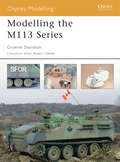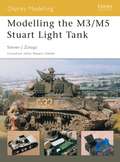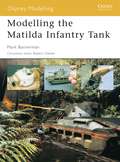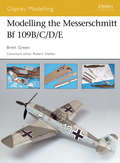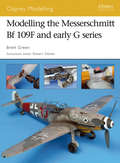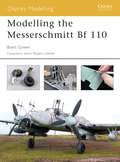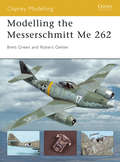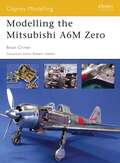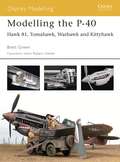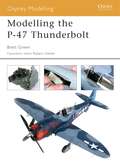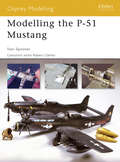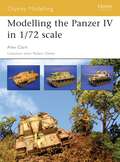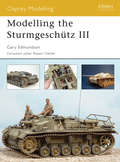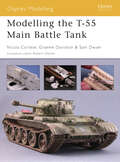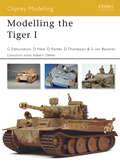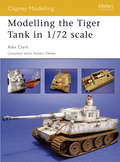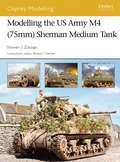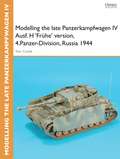- Table View
- List View
Modelling the M113 Series
by Graeme DavidsonThe M113 family of vehicles has proved to be one of the most popular military designs of the last 40 years. Introduced in the early 1960s, the series has encompassed numerous variants, served in over 50 countries and in several conflicts. This book is designed to appeal to modellers of intermediate skill and features five progressively challenging projects covering a range of different versions of the M113, including reconnaissance, fire support, APC and air defence variants. Step-by-step photos illustrate scratchbuilding, painting and weathering techniques. It also contains detailed listings of all the kits and aftermarket products available for this heavily modelled subject.
Modelling the M3/M5 Stuart Light Tank
by Steven ZalogaThe M3 and M5 Stuart were the most significant light tanks of the US Army, as well as many other allied armies, during World War II. They have proved to be popular modelling subjects ever since, largely due to the large number of kits available in many different scales covering a broad selection of the different variants used. The Stuarts were also painted in a wide range of colourful camouflage schemes, reflecting their widespread service, and this adds to their appeal. This title shows a number of different ways to model this popular tank in 1/35 scale, covering construction, painting and weathering the vehicle.
Modelling the Marder Self-Propelled Gun
by Samuel DwyerThe term Marder (meaning weasel) was the name given to this family of open-topped tank destroyers. Combining high mobility and heavy firepower, they saw significant combat action in several theatres, This book provides a detailed guide to modelling the Marder in 1/35 scale, and offers diverse challenges to modellers of all abilities. Conversions, interior detailing, kit bashing, adding aftermarket figures and parts, creating different finishes and weathering techniques are all covered in step-by-step visual detail.
Modelling the Matilda Infantry Tank
by Mark BannermanThe Matilda tank saw action in almost all theatres of World War II, from Europe to the Pacific. Born in the interwar years, and developed with numerous modifications following combat testing, the Matilda is perhaps most famous for its role in the desert campaigns of 1940-41, thus acquiring its nickname 'Queen of the Desert'. This book provides a detailed guide to modelling the Matilda tank across a variety of types, colour schemes and scales, and features excellent reference photos. Using clearly explained techniques and methods, and featuring the work of several top modellers, this step-by-step guide to building, finishing and displaying the Matilda in European, Western Desert and Australian service presents a creative and enagaging approach to modelling the 'Tilly'.
Modelling the Messerschmitt Bf 109B/C/D/E
by Brett GreenThe Messerschmitt Bf 109 was the most prominent German fighter type of World War II - over 35,000 were built and it served in many different variants and roles throughout the course of the war. It was the true workhorse of the German Luftwaffe throughout the war and continued in front-line service with some European countries for many years afterwards. This title details the early and pre-war variants, including the Bf 109s that flew in the Spanish Civil War, Poland, France and the Battle of Britain, in a series of increasingly complex construction projects. It also details the numerous kits available of this famous fighter.
Modelling the Messerschmitt Bf 109F and early G series
by Brett GreenUndoubtedly one of the most recognizable fighter aircraft in history alongside the Supermarine Spitfire and the P-51 Mustang, the Messerschmitt Bf 109 is as popular in plastic as in real life. There are almost certainly more kits and accessories of the Bf 109 across the full range of popular scales than any other modeling subject.This second Bf 109 title in the Osprey Modeling series focuses on the Messerschmitt Bf 109F and early G models, the workhorses of the German Luftwaffe during mid World War II. The Bf 109 F, Friedrich, was introduced in late 1940 to counter the increasing dominance of the Spitfire, and formed the backbone of the Luftwaffe during the invasion of the Soviet Union in 1941. The Bf 109G, Gustav, was introduced in early 1942, and became the most numerous of all the 109 variants, as well as arguably the most streamlined.Detailing six different builds across the scales from 1/44 to 1/24, and featuring aircraft in camouflage schemes and markings from the Western Desert to the Russian Steppes, this book is an excellent source of reference for both the beginner and expert modeler, on one of the most effective killing machines of World War II.
Modelling the Messerschmitt Bf 110
by Brett GreenThe Messerschmitt Bf 110 was undoubtedly one of the most significant aircraft of World War II. Despite suffering setbacks in the summer of 1940 at the hands of the RAF, it continued to be used effectively in other theatres and roles until the last days of the war, particularly as a night fighter against RAF Bomber Command's strategic bombing campaign over the Reich. This title shows you how to correct and convert basic 1/48-scale kits of the Bf 110 into many different variants, using a wide selection of aftermarket detail sets, conversions, accessories and decals for both day and night fighter schemes.
Modelling the Messerschmitt Me 262
by Robert OehlerDeveloped from a 1938 design by Messerschmitt the Me 262 Schwalbe (Swallow) was the world's first operational turbojet aircraft. First seeing combat in July 1944, it proved to be particularly effective against the large Allied bomber formations that were operating over Germany late in the war and more than 1,400 were produced, though less than 300 saw combat. This book showcases six different builds of the Me 262 across the scales from 1/72 to 1/32, across a range of skill levels. It also includes a comprehensive list of all the available kits and aftermarket products.
Modelling the Mitsubishi A6M Zero
by Brian CrinerThe A6M Rei Shiki Sento Ki (meaning Type Zero fighter) was the result of an order by the Imperial Japanese Navy for a low-wing monoplane with superior speed, range, climbing powers, and manoeuvrability. It famously served as a fighter escort during the attack on Pearl Harbor in December 1941, and ended the war as the kamikaze plane of choice. This book provides a detailed guide to modelling this popular aircraft across a variety of scales, and features an A6M2-N Rufe, a kamikaze A6M5c, an A6M2 model 21, and a captured A6M5b of TAIC #7, as well as a gallery and walkaround section.
Modelling the P-40
by Brett GreenThe P-40 was a dependable warhorse that provided valuable service throughout World War II. The earliest operational variants were used to great effect by the famous 'Flying Tigers' in China, and the P-40 went on to serve in almost every theatre of the war. Modellers are well served with P-40 variants from major manufacturers and after-market companies, and this book helps make the most of the products available. The projects featured in clear step-by-step detail include a 1/32 'Flying Tiger' P-40B, an RAAF Kittyhawk Mk.IV in 1/48, a TP-40N two-seat trainer in 1/48 and an RAF Desert Kittyhawk in 1/72 scale. Superb colour reference photographs and detailed lists of kits and accessories available round off this authoritative treatment.
Modelling the P-47 Thunderbolt
by Brett GreenThe P-47 Thunderbolt, affectionately nicknamed the 'Jug', was one of the most famous fighter aircraft of World War II. Used as both a high-altitude escort fighter and a low-level fighter-bomber, it quickly gained a reputation for being tough and resilient. Many different air forces operated this plane, and it sported a wide range of camouflage schemes, finishes and markings, including stunning nose art. Modellers have been well served with Thunderbolt kits over the years, right up to the latest highly accurate releases. This book takes a step-by-step approach to modelling a wide variety of P-47 types in 1/48-scale, from 'Razorbacks' in USAAF colours to RAF T-bolts in the Far East. It provides expert advice on conversions (including a Bubbletop to a P-47M), adding aftermarket items, detailing, and ways to achieve top quality weathering and finishes.
Modelling the P-51 Mustang
by Stan SpoonerThe North American P-51 Mustang had a humble genesis as a British request for single engine escort fighter. The projects in the book take the modeller from the aircraft's beginnings to the ultimate manifestation of this elegant and deadly bird, the F-82 G/H Twin Mustang. The North American P-51 Mustang had a humble genesis as a British request for single engine escort fighter. "Dutch" Kindelberger's North American design team created, in just six months, a prototype that would become, arguably, World War II's most important fighter aircraft. The aircraft was designed around the innovative laminar flow wing, which resulted in a much more efficient flow of air across the top of the wing, thereby reducing drag and increasing range. Modelling is the perfect format to appreciate this revolutionary design feature which created a highly maneuverable plane with excellent range. This book pays attention to the crucial details and methods needed to model the Mustang, at differing skill levels and with unique finishing tips and styles - showing the benefits of scratch built components, all illustrated in a clear concise and easy to use manner.
Modelling the Panzer IV in 1/72 scale
by Alex ClarkAlthough not as glamorous as vehicles such as the Panther and Tiger, the Panzer IV formed an extremely important part of the German armoured forces during World War II. This title provides detailed 1/72-scale build articles on a Panzer IV Ausf. H in winter camouflage, a Jagdpanzer IV, a late-version Sturmpanzer IV, a final version Sturmgeschütz IV, and a Flakpanzer IV Wirbelwind. Conversions, interior detailing, kit-bashing, adding aftermarket figures and parts, finishing and weathering, plus special scale techniques are all covered in detail. A gallery section also features Panzer IV Ausf. H, Panzer IV L/70 (V), and Panzer IV L/70 (A) variants.
Modelling the Sturmgeschütz III
by Gary EdmundsonThe concept of the Sturmgeschutz III started well before the war when the German army announced the need for a self-propelled 75mm gun to be used for infantry support. By 1938, several '0-Serie' prototype vehicles were produced on earlier style Panzer IIIB chassis by Daimler-Benz. The manufacture of the first 30 production vehicles (StuG III Ausf. A) that went into combat in the invasion of France were made at the Alkett factory in Berlin. As the war progressed, the StuG III was continuously improved with variants A through E, and then given a longer, more powerful gun starting with the Ausf. F. The role of the AFV became more diverse, and duties as a tank hunter increased. Some StuG III were allotted to Panzer companies to supplement their losses. Significant changes to the hull were made with the introduction of the Ausf. G, with the later variant of the G being produced right up until April of 1945. The StuG III chassis was also used to house the 10.5 cm Sturmhaubitze 42 L/28 howitzer, of which over 1,200 were produced by Alkett. With the low silhouette and strongly armoured hull, the StuG III proved to be one of the more significant weapons of the German forces of World War II. The book details the construction of four models in 1/35 scale, and includes a gallery feature covering all variants of the StuG III. Aftermarket products are added to the basic kits to produce accurate replicas. References are extensive on this particular vehicle, and are clearly presented as each correction or enhancement to the kits is explained.
Modelling the T-55 Main Battle Tank
by Nicola CorteseThe T-55 tank first appeared in 1958, a result of numerous improvements made to the (1949) T-54 series, and with a lineage stretching back to the wartime T-34 and the T-44. The T-55 series has seen service around the world with many armed forces, including the Warsaw Pact countries, Afghanistan, Angola, Cambodia, China, Croatia, Egypt, Iran, North Korea, Poland, Somalia, Sudan, and Vietnam, and has seen action in key modern conflicts, most recently in the two Gulf Wars. This title showcases the talents of several leading modellers, and presents Serbian, Iraqi, Czech, Syrian, and Russian variants across 1/35 and 1/72 scales. It also features several challenging projects that involve extensive scratchbuilding.
Modelling the Tiger I
by Gary EdmundsonThe Tiger has proved to be one of the most popular modelling subjects of all time, with a vast and ever-increasing range of kits, aftermarket products and references available. Probably the most famous tank of World War II, the Tiger was designed in response to the German Army's fighting experience in Western Europe, North Africa and Russia. Armed with the most powerful German gun, the famous 88mm, the Panzer VI Tiger was intended to dominate the battlefield from the East to the West.In this book, some of the world's most talented modellers cover six separate Tiger projects, their work illustrated by a collection of step-by-step color photographs detailing everything from insignia to battle damage in a variety of combat theaters to illustrate the Tiger's full wartime experience. With varying degrees of difficulty, this will appeal to both experienced modelling enthusiasts and newcomers attempting their first project.
Modelling the Tiger Tank in 1/72 scale
by Alex ClarkThe Tiger tank is probably the most famous tank of World War II. Both the Tiger I and its successor, the Tiger II, were used as bases for other German vehicles. This book covers a wide range of vehicles based on the chassis of the Tiger I and II tanks in 1/72 scale. It provides a detailed guide to modelling the basic tank versions as well as the Sturmmörser Sturmtiger (Tiger I variant), Jagdtiger (Tiger II variant) and the Panzerjäger Tiger (P) Elefant tank destroyer. A variety of camouflage schemes are described in depth, and the text covers photo-etched parts, resin aftermarket sets, scratch-building, and the use of figures and groundwork.
Modelling the US Army M4 (75mm) Sherman Medium Tank
by Steven ZalogaThe Sherman tank was the principal US and Allied tank of World War II with more Shermans manufactured than all German tanks combined. Not only were large numbers manufactured, but there was a very wide range of variants powered by different types of engines, manufactured with different types of hulls, turrets and other details. As a result, a M4A1 tank from the Tunisian campaign in 1942 had nothing in common with a M4A3E8 tank from the 1945 campaign in Germany, even if they shared the same name. Consequently, the Sherman has proven to be an enormously popular modeling subject.Due to the enormity of the subject matter, this book is the first of three planned to deal with this tank and its many variants. It covers the early 75mm Shermans and runs the gamut from the US Army in Tunisia in 1942-43, Italy in 1943-45 and NW Europe in 1945. In so doing, it covers the broadest possible range of variants and details. The builds include:1.M4A1, 2/13th Armored in Tunisia 1942/43. This is mainly 'out of the box', and deals with cleaning up and correcting the popular Dragon kit and painting it in desert colors. 2.M4A3, 6th Armored Division, Battle of the Bulge, January 1945: an intermediate level build, correcting and enhancing the Tamiya kit, and dealing with the issue of assembling aftermarket (separately available add-on components) link-to-link tracks. 3.M4A1, 2nd Armored Division, Sicily 1943. This is actually an earlier version of the M4A1 than the first type (2nd Armored having been the first division with the Sherman); an advanced level project using the Formations resin hull for the proper 'direct vision' early hull. 4.M4, 8th Tank Battalion, 4th Armored Division, Normandy, July 1944: the 'super'project, including a number of advanced techniques such as swapping the suspension on the Tamiya kit, applying foliage camouflage, building and painting a turret interior and adding figures to the model.The book also showcases a number of other Shermans already built by the author to demonstrate the variety available.
Modelling the late Panzerkampfwagen IV Ausf. F2, Panzer-Regiment 8, 15.Panzer-Division, Deutsches Afrika Korps, 1942
by Tom CockleThe Panzerkampfwagen IV was the only German tank to have been produced continuously throughout the whole of World War II, going through several upgrades and improvements along the way. With the Panzerkampfwagen III, it provided the backbone of the Panzer Divisions over the years of both victory and defeat. This guide covers the Panzerkampfwagen IV Ausf. F2, Panzer-Regiment 8, 15.Panzer-Division, Deutsches Afrika Korps, 1942. This guide also features a gallery of other Panzer IV modelling projects. Further information for the modeller including a list of museums and collections, further reading, websites and a comprehensive list of available aftermarket products and kits of all scales is also available. This guide forms part of Osprey Modelling 38 Modelling the Late Panzerkampfwagen IV ebook.
Modelling the late Panzerkampfwagen IV Ausf. H 'Frühe' version, 4.Panzer-Division, Russia 1944
by Tom CockleThe Panzerkampfwagen IV was the only German tank to have been produced continuously throughout the whole of World War II, going through several upgrades and improvements along the way. With the Panzerkampfwagen III, it provided the backbone of the Panzer Divisions over the years of both victory and defeat. This guide covers the Panzerkampfwagen IV Ausf. H 'Frühe' version, 4.Panzer-Division, Russia 1944. This guide also features a gallery of other Panzer IV modelling projects. Further information for the modeller including a list of museums and collections, further reading, websites and a comprehensive list of available aftermarket products and kits of all scales is also available. This guide forms part of Osprey Modelling 38 Modelling the Late Panzerkampfwagen IV ebook.
Modelling the late Panzerkampfwagen IV Ausf. J, 5.Panzer-Division, East Prussia, 1944
by Tom CockleThe Panzerkampfwagen IV was the only German tank to have been produced continuously throughout the whole of World War II, going through several upgrades and improvements along the way. With the Panzerkampfwagen III, it provided the backbone of the Panzer Divisions over the years of both victory and defeat. This guide covers the Panzerkampfwagen IV Ausf. J, 5.Panzer-Division, East Prussia, 1944. This guide also features a gallery of other Panzer IV modelling projects. Further information for the modeller including a list of museums and collections, further reading, websites and a comprehensive list of available aftermarket products and kits of all scales is also available. This guide forms part of Osprey Modelling 38 Modelling the Late Panzerkampfwagen IV ebook.
Modelling the late Panzerkampfwagen IV Ausf. J, II.Panzer-Division, Kotzing, Bavaria, 1945
by Tom CockleThe Panzerkampfwagen IV was the only German tank to have been produced continuously throughout the whole of World War II, going through several upgrades and improvements along the way. With the Panzerkampfwagen III, it provided the backbone of the Panzer Divisions over the years of both victory and defeat. This guide covers the Panzerkampfwagen IV Ausf. J, II.Panzer-Division, Kotzing, Bavaria, 1945. This guide also features a gallery of other Panzer IV modelling projects. Further information for the modeller including a list of museums and collections, further reading, websites and a comprehensive list of available aftermarket products and kits of all scales is also available. This guide forms part of Osprey Modelling 38 Modelling the Late Panzerkampfwagen IV ebook.
Modern Afghanistan: The Impact of 40 Years of War
by M. Nazif ShahraniWhat impact does 40 years of war, violence, and military intervention have on a country and its people? Modern Afghanistan is a collection of the work of interdisciplinary scholars, aid workers, and citizens to assess the impact of this prolonged conflict on Afghanistan. Nearly all of the people in Afghan society have been affected by persistent violent conflict. Issues considered in this volume include social and political dynamics, issues of gender, and the shifting relationships between tribal, sectarian, and regional communities. Contributors consider topics ranging from masculinity among the Afghan Pashtun to services offered for the disabled, and from Taliban extremism to the role of TV in the Afghan culture wars. Prioritizing the perspective and experiences of the people of Afghanistan, the contributors offer new insights into the lives of those who are hoping to build a secure future on the rubble of a violent past.
Modern African Wars
by Paul Hannon Helmoed HeitmanFrom the days of its occupation by South African forces under the Mandate System, to its first election in 1989, South-West Africa was a hotbed of revolutionary activity. The establishment of SWAPO (South-West African People's Organization) in 1960, sparked decades of guerilla warfare, mostly aimed at the South African military. This book examines modern African wars between 1964 and 1989, and includes detailed descriptions of the South African Defence Force, Angolan Forces, SWAPO, and the major units involved in the counter-insurgency campaigns. The text is enhanced by colour plates, maps, and numerous photographs.From the Trade Paperback edition.
Modern African Wars
by Peter Abbott Mike ChappellThe Rhodesian War of 1965-80 is the battle for control of present day Zimbabwe. The former British colony of Southern Rhodesia rejected British moves towards majority rule and on 11 November 1965 the Rhodesian Prime Minister Ian Smith announced his country's Unilateral Declaration of Independence from Great Britain. That act sparked a series of violent encounters between the traditional colonial army and the African guerilla insurgents of the Patriotic Front. This book examines the successes and failures of the counter-insurgency campaign of Smith's security forces and the eventual bloody birth of a modern African nation.From the Trade Paperback edition.
